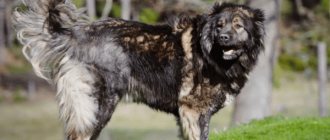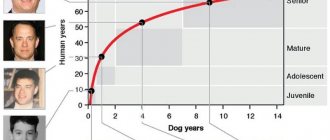There are many unscrupulous owners. Some people do not carefully monitor animals - dogs run away, others throw an animal that does not suit them into the street. When a dog is selected and found, the question arises of how to determine the dog’s age. This is necessary for examination by a veterinarian, vaccination, to create an announcement about the foundling, in order to know how to care for it, what to feed and how long to walk.
To determine the age, the pet is examined. As a person grows and ages, special signs appear, similar to what happens in animals. A puppy cannot be confused with an old animal. Veterinarians know how to find out a dog’s age more accurately by external signs. And among dogs there are long-lived people. The oldest dog died at 29 years old, but this is a rare exception. Most dogs live 10-16 years.
The second common question among pet owners related to age is whether it is possible to compare it with a human one. Knowledge is not very important, but interesting. The age of a dog by human standards can be approximately calculated using coefficients or viewed more accurately in special charts.
Relationship between a dog's age and human years
Are you wondering how old your four-legged friend will be, in human age? To get the equivalent human age of a pet, you just need to multiply it by 7 or 6. This is approximately the case. Compare: dogs reach adulthood already at the age of two, when people need 18 years to do this. At 18 months, the dog will feel as fresh and cheerful as a person at 20.
On average, a dog lives up to 12 years. The figure depends on the breed, quality of life, genetics and other factors. Converted to human years, this would be approximately 64-77 years. When a dog turns 16, he feels like a full-fledged 90-year-old inhabitant of our planet.
There is another version. To obtain a dog's age similar to a human's, the multipliers must be gradually changed. For example, when a puppy is 2 months old, we multiply its age by 7, we get 14 human years. But upon reaching the age of six months, the puppy jumps sharply in development and its age is already equal to 5-6 human years, since the multiplication coefficient immediately changes to 10. 1 year is equal to 15 human years.
It is impossible to compare human and dog (or cat) ages with 100% objectivity, so we are content with those calculations that are quite realistic to make.
Features of determination depending on breed
Breed affects the physical development of dogs, which means it is important to take them into account to find out how old your pet is.
Small breeds
The smallest dogs are distinguished not only by their size, but also by their friendly character, ease of care and great devotion to their owner. They are also long-lived.
Spitz, Yorkies and other small breeds begin to breed early. The first heat can begin at the age of six months. Their teeth take a long time to form – up to 11 months. Larger pets can grow for up to two years, but representatives of small breeds already show off physical maturity by the first year of life.
Medium breeds
Medium breeds include French bulldog, cocker spaniel, collie, sharpei and others. At the age of one and a half to two years, these animals can reach 10-25 kg. Use the breed information, weigh the dog and determine how old your dog is.
Representatives of medium breeds become adults at the age of one and a half years. At 9 months they already have molars.
Large breeds
Representatives of these breeds grow much longer than their smaller counterparts. For example, an adult Labrador can weigh 30-39 kg depending on gender, and a Doberman can weigh 28-44 kg. Large breed dogs weigh at least 25 kg as adults.
By the way, these pets remain puppies for up to two years and will be just as inquisitive and playful. A significant disadvantage is that large and giant breeds do not have longevity and live only 8-10 years.
Determining the age of the puppy
Finding out how many months a puppy is is not as difficult as an adult dog.
- A newborn puppy can be identified just by looking at the four-legged animal. His eyes are closed and there are no teeth at all. The puppy does not walk yet, he sleeps most of the time. The baby just squeaks quietly to attract her mother's attention. Using touch, he finds his mother's nipples and feeds only on breast milk. It will remain this way until about 2-3 weeks of life.
- After the first weeks, the puppy’s eyes gradually open, but he still cannot see fully. Gradually he distinguishes sounds and smells.
- From the first month of life, the baby begins to walk and explore the world around him. The exact age from a month to a year can be determined by the condition of his teeth. Up to 2 months, your pet’s baby teeth are just forming. Starting from the second month of life, baby teeth are replaced by molars. By the age of 1 year, the dog's molars should be fully formed. Between 6 and 12 months, puppies begin puberty, and girls go into heat.
- From 1 to 2 years old, a dog is considered a teenager. Dogs of large and medium breeds stop growing at this age. Large breed puppies continue to develop until they are 2 years old. Starting from the age of two, the pet is considered an adult.
What does knowing the age of a pet give?
The reasons why it is important to determine how old a dog is are:
- If your pet gets sick , knowing its age will allow the veterinarian to quickly and accurately determine the disease. At different periods of an animal's life, certain diseases are most likely to occur.
- To plan vaccinations, you need information about the number of years your four-legged friend has lived. Dogs at a young age are vaccinated annually. As you get older, the frequency of vaccinations gradually decreases. This is due to the fact that an older pet has less immunity, and frequent vaccinations negatively affect its health.
- Knowing how many years a dog has lived allows us to determine whether the animal is capable of procreation.
- Information about the animal's life expectancy is important for sterilization . Spaying too early or too late will harm your pet's health.
- Veterinarians recommend choosing proper nutrition
Teeth
It is easy to determine the age of a dog by looking at its teeth. Veterinarians and dog handlers most accurately determine the age of an animal precisely by the condition of its teeth. Below is a complete table of the relationship between the number of teeth a dog has and its age.
| Age | Dental condition |
| From birth to 2-3 weeks | No teeth |
| 3-4 weeks | Milk hooks and fangs are just beginning to emerge |
| 4-5 weeks | Deciduous incisors appear |
| 5-7 weeks | The remaining teeth are emerging |
| 2 months | All baby teeth are there |
| 2-4 months | First, hooks and fangs are replaced with molars. |
| 3-5 months | Middle incisors change to molars |
| 4-6 months | Deciduous rear incisors are replaced by molars |
| Six months | Baby fangs are the last to fall out |
| 1 year | White teeth with tubercles |
| 2 years | On the lower toes, the tubercles are gradually worn away, but the teeth do not lose their beautiful appearance |
| 4 years | The upper tubercles wear away, the teeth lose their brightness |
| 5 years | Yellow plaque on teeth, possible formation of tartar |
| 6 years | Teeth are yellow, wear out, change shape |
| 8-10 years | The fangs are dull, the teeth are very worn. The enamel is clearly yellow |
| Over 10 years old | Teeth loosen and fall out, bite is disrupted |
Method number 2. According to muscle condition
There is another way to approximately determine the age of a dog as a result of an external examination. This is the feeling of the animal's muscles.
- If you feel elastic, strong muscles under your hands, then the pet is young. Like a person, he is full of strength and energy. Most likely, he will be constantly on the move, and he will not need much time to rest.
- If you feel flabby muscles or even signs of obesity when palpating, then most likely this is an elderly animal. Here we must make a digression and say that a dog is considered elderly from the 8th-9th year of life (if translated into human years, this is approximately more than 60 years). Such an animal will sleep more than be active. Calluses may be felt on the bends of the joints. The stomach drops.
By external signs
Umbilical cord. The presence of an umbilical cord indicates that the puppy was recently born. If the umbilical cord is still fresh, the puppy is no more than a day old. On the 2nd day it dries up, and on the 3rd it is already separated from the dog’s belly.
Eyes. The puppy remains blind until 10-20 days of its life. The eyes should open before the first month. The cloudy and gray-blue color of the iris is characteristic of tsutsiki for up to a month. Clear eyes are characteristic of dogs one month and older. It is worth paying attention to the dog's gaze.
Ears. In the first days of life, the puppy does not hear anything. The baby will begin to recognize the first sounds only after the second week of life, and to fully hear by the month. As the puppy grows, its ears grow.
Weight. Obviously, a small puppy will weigh differently than an adult dog. There are tables of approximate weights for small and large breeds at all ages.
For dwarf breeds:
| Type | Newborn | 4 weeks | Six months | One and half year |
| Dwarf | 70-80 grams | 200-230 grams | 715-920 grams | 1-1.2 kg |
| Small | 90-100 grams | 270-320 grams | 1-1.2 kg | 1.4-1.9 kg |
| Average | 120-130 grams | 455-485 grams | 1.6-1.8 kg | 2.1-2.3 kg |
| Big | 145-170 grams | 540-650 grams | 1.9-2.2 kg | 2.4-3 kg |
For large and medium breeds, other parameters are presented. Knowing how much a dog of a particular breed should weigh at maturity, you can find out whether it has reached canine adulthood.
You need to be especially careful with giant breeds, as their dimensions develop very, very rapidly. One-month-old Labrador puppies weigh from 3.4 to 3.6 kg and grow to 30-40 within two years. The weight of an 11-month-old Rottweiler can already reach 50 kg.
Life expectancy and age groups
Dogs live on average from 9 to 20 years. This factor largely depends on the size of the animal. Small breed dogs usually live to older ages than their larger counterparts. Giant dogs such as mastiffs, Great Danes and St. Bernards have the shortest life cycle. There are three main groups into which all dogs can be roughly divided:
- puppy;
- young animals;
- adult representative of the species.
Technically, a dog can be considered a puppy for the first two months of its life
From the moment of birth until 8 weeks, the animal is considered to be a puppy. From this age until reaching 18 months - young animals. Dogs over this age are considered adults.
Adult age
It is considered more difficult to accurately determine the number of years a dog is after three. The fact is that a dog’s age is determined mainly by its teeth. After the formation of all molars, the animal does not undergo any changes for a long time.
The dog develops fully during the second year of life. A dog that has reached not only sexual, but also behavioral maturity is considered fully mature. What distinguishes an adult dog from a puppy is a change in its behavior with others.
How to determine the physical maturity of a dog? Bitches reach puberty much earlier than males. At the age of 6-8 months, girls begin their first heat. If you notice an animal in heat, this means that she is definitely older than 8 months. It is important to monitor her all this time and prevent early pregnancy. Only a girl who has already reached 18 months of age is suitable for reproduction. Boys are also recommended to be crossed only after reaching the age of two.
A pet that has reached the age of seven can be considered elderly. Characteristic signs that the dog is old:
- The pet becomes less active, sleeps a lot, does not want to go for long walks;
- Gray hair on the face appears in a pet when it reaches 6-7 years of age. It also happens that gray hairs are found in younger individuals;
- Deterioration of hearing and vision. Partial deafness;
- Temperament changes, the animal becomes more aloof;
- Decreased appetite;
- There is no sexual desire and desire to play and meet other dogs;
- Frequent urge to urinate, problems with digestion.
The above signs are normal for an older dog. But if such oddities are noticed in the behavior of an animal that, according to other signs, has not reached the age of seven, this may indicate various kinds of diseases. Be carefull!
Stages of growing up
Before you begin to determine the age of your ward, you need to familiarize yourself with which pet is considered an adult and which one will still grow.
An adult is considered from the moment of puberty, but it occurs at different times in different breeds. Physical development is also important so that the female can bear and give birth to healthy offspring. Therefore, maturity can occur either at 6 months (in dwarf breeds) or at two years of age. Below is an approximate delineation of the stages of maturation of dogs.
- Puppy – up to 6 months.
- Teenager – from 6 months to one and a half years.
- Adult – from 2 to 8 years.
- Elderly - after 7 years.
Females reach puberty earlier than males. On average, by 8 months the first heat may begin.
An elderly dog can be identified by characteristic signs: poor hearing and poor vision, decreased activity, gray hair on the face, weak appetite, problems with bowel movements and urination, incontinence, tumors. Do not forget that these signs can be symptoms of diseases, and not just indicators of age.
If you have adopted a stray animal, show it to a veterinarian as soon as possible, who will diagnose whether these are symptoms of disease or senile illness.
Medium dogs up to 12-25 kg
Medium breeds are considered to be those that reach 10 to 25 kg in weight at the age of 1.5-2 years. To determine the age of a dog, take a look at the table below. Here are the most popular breeds and their ideal weight at maturity (+- a couple of kilograms). To understand whether your dog has passed the 1.5 year mark, weigh him and compare him with the table.
| Breed name | Weight of bitches, kg | Male weight, kg |
| French Bulldog | 11,3-12 | 13-14 |
| Cocker Spaniel | 11,8-13 | 13-15 |
| Staffordshire Bull Terrier | 21 | 24-25 |
| Collie | 19-21 | 23,9-24,4 |
| Siberian Husky | 18,5-19,5 | 24-25 |
| Shar Pei | 18-20 | 24,9-26 |
How to influence a dog's lifespan
The lifespan of a dog directly depends on lifestyle, nutrition, and living conditions.
To prolong the life of your four-legged friend, ensure health and maintain physical activity, experts advise enveloping him with care and attention from an early age.
A dog’s immunity is formed from puppyhood and significantly influences its further existence.
It is important to provide the baby with feasible physical activity and monitor the diet, which should be balanced and contain the norm of nutritional supplements, vitamins and minerals
The dog’s diet includes poultry, rabbit, veal, beef, chicken and quail eggs, fresh vegetables and herbs, cereals (rice, buckwheat, oats), white fish, dairy products, butter and unrefined vegetable oil.
It is important to control portions to prevent your dog from overeating.
Weight gain provokes rapid wear of joints and affects the functioning of the cardiovascular system. As a result, the pet lives less than it could with a normal lifestyle.
Prevention of infectious diseases is the basis of a dog’s longevity. The pet must receive vaccinations according to age according to the vaccination schedule, which increases life expectancy by 2-5 years. Timely diagnosis of hereditary diseases will help to avoid serious consequences and begin treatment on time.
Proper upbringing involves teaching your dog how to behave. Thanks to this, it is possible to avoid accidents on the roadway or in a body of water. For example, Akita Inu are completely devoid of fear of heights, and can jump from a balcony on the 5th floor after a cat or a pigeon. In such cases, it is necessary to protect the pet - equip the balcony according to the rules and teach it to restrain its impulses. In addition, fearless representatives of small breeds can suffer in a fight with a larger dog. Therefore, the main task of the owner is to monitor his pet while walking.
The psychological atmosphere in the family also affects the life expectancy of dogs. Pets raised in love, care and harmony with others live to a ripe old age, and psychosomatic pathologies are unknown to them.
Representatives of long-haired breeds require more careful care. Long-eared dogs require special care for their ears. Nail trimming, teeth and eye cleaning are mandatory procedures for all dogs.
Large from 25 kg
Large breeds are those whose weight ranges from 25-40 kg. Anyone who weighs more is considered a giant. The formation of such breeds as the Rottweiler or the German Shepherd completely ends when they reach two years of age. Puppies are already born large, weighing 3-4 kg.
| Breed name | Weight of bitches, kg | Male weight, kg |
| Golden Retriever | 30 | 33,7 |
| Labrador | 30-34 | 35,5-39,5 |
| German Shepherd | 28,4-30 | 35,9-40 |
| Boxer | 28,8-31 | 33,9-38 |
| Doberman | 28-33 | 39-44 |
| Rottweiler | 39,7 | 46,8-54 |
| Saint Bernard | 61-67 | 81-88 |
How to find out your age yourself
How to determine the age of a dog? Before understanding this issue in more detail, you should divide the dogs into age categories. Conventionally, there are three of them:
- puppies;
- young animals;
- adults.
In general, separating one category from another is quite simple. But finding out how old the dog is (at least approximately) will be a little more difficult. There are several ways to determine the age of a puppy or adult dog by external signs.
Attention! The most effective and reliable option is to check your dog's teeth. Determination by teeth
Tough
With puppies everything is quite simple. How many months a baby is can be determined by looking at his teeth. It is also worth noting that most specialists (veterinarians and dog handlers) use this method. In addition, if you know the shape and structure of teeth in each age category, you can also find your bearings based on an adult dog.
Just like humans, dogs change their teeth from baby teeth to molars once during their lives. Keeping this in mind, you can easily find out the approximate age of your pet.
The distribution by week, month and year is as follows:
| Dog's age | Dental condition |
| From birth to 2-3 weeks | None |
| 3-4 weeks | Hooks and fangs appear (milk) |
| 4-5 weeks | Incisors appear |
| 5-7 | All other teeth are coming through |
| By 2 months | A fully formed set should appear |
| Up to 4 months | Hooks change from milk to root |
| Up to 5 months | Incisors change |
| Up to 6 months | Changing back teeth from baby teeth to molars |
| By 6 months | The entire set of teeth is completely replaced |
| From 1 to 2 years | The teeth are white, there are small tubercles on the surface, the shape resembles a trefoil |
| From 2 to 4 | The bumps on the surface disappear, the color becomes duller, and gray shades appear. Externally, the teeth remain very beautiful |
| From 5 | A yellow plaque gradually appears, the fangs become dull, their shape changes, and tartar may appear. |
| 8-10 years | Significant wear occurs and the fangs become dull. Yellow plaque becomes more noticeable |
| Over 10 | Teeth begin to loosen and fall out. The bite is disturbed and caries appears. |
The structure of teeth at different ages
According to muscle condition
How else can you find out the age of a dog? The second way to help you decide is the condition of your muscles.
Every owner knows that young pets are more active and playful. Their behavior is strikingly different from their elderly relatives. They are always ready to run, jump, frolic, chase a ball, and so on. On the other hand, older dogs prefer to move calmly, measuredly, and are already reluctant to chase a stick.
A less active lifestyle inevitably leads to muscles losing their tone, becoming more flabby, and losing elasticity.
The well-developed muscles of a young dog can be felt with normal stroking. From constant running and physical training, the muscles become literally stone and embossed.
According to the condition of the coat
Determining the age of an animal by the condition of its fur is quite difficult. In most cases, experts rely on this indicator as a last resort, and sometimes do not take it into account at all. The thing is that the condition of the coat greatly depends on how well a person took care of the appearance and condition of the animal.
The traits of the breed, as well as the conditions in which the animal was located, are no less important. If we talk about puppies, then with good maintenance and care, their fur remains soft and fluffy for up to six months. With age, it gradually becomes tougher. The first molt begins at 6 months.
However, even a young dog can have hard, matted fur if he lived on the street, or if his owners simply rarely bathed him.
Attention! In older dogs, the hairs begin to slowly turn grey, primarily in the muzzle area. Gray hair may appear over the years
By the eyes
The age of the animal will also be determined very conditionally by the eyes. Yes, young pets, as a rule, have a perky and playful look, with a bright iris. Gradually, with age, the gaze begins to dim and become more cloudy.
However, these are only indirect signs, since dull eyes can be an indicator not only of old age, but also of serious illness. In addition, there are many ailments that negatively affect the visual organ.
If there is no clear certainty or it is impossible to determine the age of the pet, it is recommended to seek help from a veterinarian.
Tough
The expert will first look at the condition of the animal’s teeth. By the presence or absence of certain fangs, you can find out the age of the puppy. The age of an adult dog is determined by the presence of all molars and cusps on them. Above is the most complete table showing the correspondence between the years of an animal’s life and the approximate condition of its jaws.
The disadvantage of this method is that if the dog has a malocclusion or other jaw defects, diagnosis becomes difficult.
Method No. 3. According to the condition of the coat
You can study the animal's fur. Of course, the condition of the coat is influenced by too many factors (living conditions, past illnesses, psychological state, and nutrition), but, in principle, the main age can be named.
- If the coat is soft, “fluffy”, then you have a puppy under 1 year of age.
- If the coat is “adult”, silky, shiny in appearance, then the dog is young – no more than 2-3 years.
- If there are gray hairs in the coat, there is no shine, or even the coat is not uniform, then the dog is not of a young age. And the duller the hairline, the older the age. Gray hair in the muzzle area appears at 6-7 years of age.
However, you need to understand that “bad” wool can also be the result of poor care or a serious illness. Gray hair can also appear in young individuals.
According to other signs
By behavior. Little puppies love to be near their mother. They do not leave their mother, sleep, eat and play nearby, and puppies up to two weeks old cannot do anything on their own. Since a month they have been actively studying everything and walking around. From two months and older, the puppy is already running around the house with all his might and doing mischief here and there. By six months, small breeds begin puberty; large breeds mature by up to a year. Character is formed around 4-5 months.
Barking. The puppy begins to bark at 1.5-2 months of age. His voice is not so loud, but ringing and perky.
Reaction to sound. Puppies cannot fully hear until they are a month old. If the puppy does not respond to sound stimuli, either he is not 2 weeks to a month old, or he is deaf or has problems with his ears.
So, let's start examining the puppy.
If the baby’s umbilical cord has not even dried yet, then in front of you is a lump that was born literally 1-2, maximum three days ago
If the umbilical cord is dry, then we pay attention to whether the baby has hearing. No? This means the dog is not even one week old yet, because hearing begins to emerge from 7-9 days, but it develops gradually, not immediately
Immediately after the appearance of hearing, the eyes begin to gradually open, usually this happens in the second week, approximately 10-12 days.
And that’s all, the period has ended when you can very accurately and very easily determine the age of a puppy. If he is more than a month old, then the approximate date of birth can only be determined by his teeth. Most likely, a veterinarian will do this, but you can do it, guided by the information below.
Briefly about the main thing
- You can find out the age of your pet yourself, without the help of a veterinarian.
- First of all, look at the teeth, since the condition of the teeth can most accurately tell how old the dog is.
- Don't rush to judge prematurely. To complete the picture, conduct a full examination of the dog. This way you can objectively assess the situation and make the most accurate conclusion about its age.
Have we answered your question fully enough? If not, write your question in the comments below and our specialist will answer it.
Did you like the article? Share it with your friends on social media. networks. This will help them get useful information and support our project.
Indication of age in documents
By purchasing a purebred puppy, the owner receives a pedigree registered with a canine organization with information about ancestors, indicating the date of birth, nickname, brand or chip. There must be reports on the mating of breeding dogs and on the examination of the baby.
In the veterinary passport, the doctor enters information about the animal’s date of birth, the owner’s contact information and notes on the preventive measures taken.
LeBeau theory
In 1950, a new, more accurate method of recalculating a dog's age to a specific human age was proposed.
The author of the method, French veterinarian LeBeau, studied in detail the stages of growth and development of the animal and human body. The scientist proposed using coefficients that would vary depending on average life expectancy, puberty and maturity in pets and people.
The number of years a pet has lived by human standards, taking into account coefficients, is reflected in Table 1.
Thus, in terms of development, a one-year-old dog corresponds to the development of a 14-15 year old teenager , and in the second year of life he lives another 9 human years. Each subsequent year lived, the four-legged friend adds another 4 years.
However, LeBeau's theory does not take into account the characteristics of the growth and development of the animal, taking into account its breed characteristics.
When does a dog get older?
The period in which an adult dog begins to be older depends not only on the date of his birth, but also on his body weight. Giant dogs (over 50 kg) become elderly already at the age of 5 years, while up to 10 kg only after 3 years, that is, at the age of 8 years.
| Dog body weight | Dog age |
| > 50 kg | 5 years |
| > 30 kg | 6 years |
| > 10 kg | 7 years |
| <10 kg | 8 years |
The table shows at what age dogs become seniors depending on their body weight.











